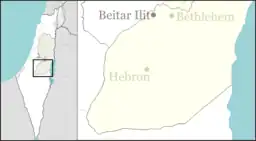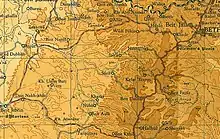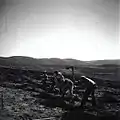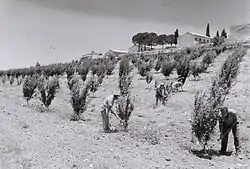Kfar Etzion
כְּפַר עֶצְיוֹן | |
|---|---|
 | |
 Kfar Etzion | |
| Coordinates: 31°38′56″N 35°6′55″E / 31.64889°N 35.11528°E | |
| District | Judea and Samaria Area |
| Council | Gush Etzion |
| Region | West Bank |
| Affiliation | Religious Kibbutz Movement |
| Founded | 1927 (original) 1934, 1943, 1967 (re-establishments) |
| Founded by | Yemenite immigrants |
| Population (2021)[1] | 1,278 |
| Website | k-etzion.co.il |
Kfar Etzion (Hebrew: כְּפַר עֶצְיוֹן, lit. Etzion Village) is an Israeli settlement in the West Bank, organized as a religious kibbutz located in the Judean Hills between Jerusalem and Hebron in the southern West Bank, established in 1927, depopulated in 1948 and re-established in 1967. It is located 4.7 km east of the Green Line and falls under the jurisdiction of Gush Etzion Regional Council.[2][3] In 2021, Kfar Etzion had a population of 1,278.
The majority of the international community considers Israeli settlements in the West Bank illegal under international law, but the Israeli government disputes this.[4]
History
Migdal Eder
In January 1927, the Zikhron David society, a group of Orthodox Jews from the Mea Shearim neighborhood of Jerusalem, established a small farming community, Migdal Eder, on land near to the present site of Kfar Etzion.[5] The name was taken from a verse in the Bible, Genesis 35:21, which referred to a tower of the same name.[6] A group of 15 families, including 12 Yemenite families, settled on the land.[5] The farming outcomes were very disappointing and pleas for help from the Zionist Executive and the Palestine Jewish Colonization Association were rejected.[5] After one year, only 7 families remained.[5] At the onset of the 1929 Palestine riots, the remaining settlers fled and local Arabs destroyed the buildings.[5] Residents of the neighboring Palestinian village of Beit Ummar sheltered the farmers, but they could not return to their land.[6]
El haHar
The El haHar ("to the mountain") settlement company was founded by Shmuel Zvi Holzmann in 1933.[7] Holzmann bought land, mostly from Migdal Eder, and leased land from a nearby Russian convent.[7] The intention was to found three settlements: Kfar Etzion, Pri-Amal and Ya'ar Etzion.[7] The name "Etzion" was a play on Holzmann's own name, as "Holz" means "wood" in German and Yiddish, while "etz (עץ)" means "wood" in Hebrew. However workers preparing the site left in 1936 due to the beginning of the Arab Revolt.[7] Much of the land was purchased by the Jewish National Fund to keep it in Jewish hands.[7]
Old Kfar Etzion
In the early 1940s, additional land in the area was purchased by the Jewish National Fund, including some from a Benedictine monastery and some from Arabs (despite the 1939 White Paper's ban on land sales to Jews in the area).[7] The site of Kfar Etzion was settled in 1943 by Kvutzat Avraham of the religious Hapoel HaMizrachi movement.[7] During the next four years, three additional kibbutzim were founded in the area, creating what became known as the Etzion bloc.[7] All of them were destroyed in the 1948 Arab-Israeli War, and the entire area came under Jordanian rule.[6]
The kibbutzim held off the attacks for ten days until Kfar Etzion fell on 14 May 1948. In the fighting, 157 Jewish defenders died, including a number who were the subjects of the Kfar Etzion massacre, killed after surrendering.[8] The other three kibbutzim surrendered. The inhabitants there were taken as prisoners of war and released nine months later.[9]
_overlaid_on_the_1943_Survey_of_Palestine_map_of_Beit_Fajjar.jpg.webp) The four kibbutzes of the Gush Etzion at the time of the 1948 war (Kfar Etzion, Ein Zurim, Massuot Yitzhak, Revadim) overlaid on a 1943 Survey of Palestine map
The four kibbutzes of the Gush Etzion at the time of the 1948 war (Kfar Etzion, Ein Zurim, Massuot Yitzhak, Revadim) overlaid on a 1943 Survey of Palestine map Kfar Etzion water tank, 1943
Kfar Etzion water tank, 1943 Kfar Etzion (Kefir 'Etsyon) 1945, 1:250,000
Kfar Etzion (Kefir 'Etsyon) 1945, 1:250,000 Kfar Etzion 1945
Kfar Etzion 1945 Neve Ovadia library exterior 1946
Neve Ovadia library exterior 1946 Kfar Neve Ovadia reading hall
Kfar Neve Ovadia reading hall Kfar Etzion 1946
Kfar Etzion 1946 Kfar Etzion 1947
Kfar Etzion 1947 Kfar Etzion, 1947
Kfar Etzion, 1947 Kfar Etzion 1948
Kfar Etzion 1948
New Kfar Etzion settlement
In 1967 Israel occupied the West Bank in the Six-Day War. The Israeli cabinet decided to re-establish the settlement of Kfar Etzion despite receiving legal advice that establishing such settlements in occupied territory would be illegal under the Fourth Geneva Convention.[10] A key figure identified with Kfar Etzion's reestablishment after 1967 is Hanan Porat, who lived on the kibbutz as a child prior to its destruction in 1948.[11][12]
Another figure involved in Kfar Etzion's resettlement is Elyashiv Knohl, a rabbi of the community whose father fought in the 1948 Arab–Israeli War and was captured during the war by the Jordanians. According to Knohl, Kfar Etzion's original settlers were socialists, and members of the kibbutz continue to channel their incomes to a joint account.[2] Today Kfar Etzion houses a museum and archive documenting the history of Gush Etzion.
In the 2013 Middle East cold snap a meter of snow fell on the Kfar Etzion area.
Economy
Residents of Kfar Etzion earn their livelihood growing cherries, flowers, olives, almonds, and grapes. Some raise chickens, and others work in Jerusalem. As of 2012 there was a large clothing store on the settlement. In 2012 the price of a 120-square-meter home on the settlement was ILS1.1 million while the price of a 200-square-meter home was ILS1.8 million.[2]
See also
References
- ↑ "Regional Statistics". Israel Central Bureau of Statistics. Retrieved 22 February 2023.
- 1 2 3 Yahav, Nir; Breiner, Yehoshua (12 June 2012). נוהל שכן: בין העיירה בית אומר להתנחלות כפר עציון. Walla! News (in Hebrew). Retrieved 8 September 2012.
- ↑ "Gush Etzion". Gush Etzion. Archived from the original on 5 September 2011. Retrieved 24 August 2011.
- ↑ "The Geneva Convention". BBC News. 10 December 2009. Retrieved 27 November 2010.
- 1 2 3 4 5 Kark, Ruth; Oren-Nordheim, Michal (2001). Jerusalem and its Environs; Quarters, Neighborhoods, Villages 1800–1948. The Hebrew University Magnes Press. pp. 342–345. ISBN 0814329098.
- 1 2 3 "Settlements in Focus: Gush Etzion". Archived from the original on 28 June 2016.
- 1 2 3 4 5 6 7 8 Kark, Ruth; Oren-Nordheim, Michal (2001). Jerusalem and its Environs; Quarters, Neighborhoods, Villages 1800–1948. The Hebrew University Magnes Press. pp. 338, 358. ISBN 0814329098.
- ↑ Benny Morris (3 October 2003). The Road to Jerusalem: Glubb Pasha, Palestine and the Jews. I.B.Tauris. p. 269. ISBN 978-1-86064-989-9.
- ↑ Moshe Dayan, 'The Story of My Life'. ISBN 0-688-03076-9. Page 130. Describes negotiations with Abdulla el-Tel about the release of 670 Israelis in the "Jordan POW camp at Mafrak." He states that 320 of them were from the Etzion bloc, including 85 women.
- ↑ Donald Macintyre, Secret memo shows Israel knew Six Day War was illegal. Independent, 26 May 2007. (on web.archive)
- ↑ Bronner, Ethan (4 October 2011). "Hanan Porat, Jewish Settlement Leader, Dies at 67". The New York Times. Retrieved 8 September 2012.
- ↑ Lis, Jonathan; Levinson, Chaim (5 October 2011). "Hanan Porat, 1943 – 2011 / Pioneer of settler movement". Haaretz. Retrieved 8 September 2012.
Further reading
- Yossi Katz, Between Jerusalem and Hebron: Jewish Settlement in the Pre-State Period
External links
- Official website (in Hebrew)
- Peace Now fact sheet